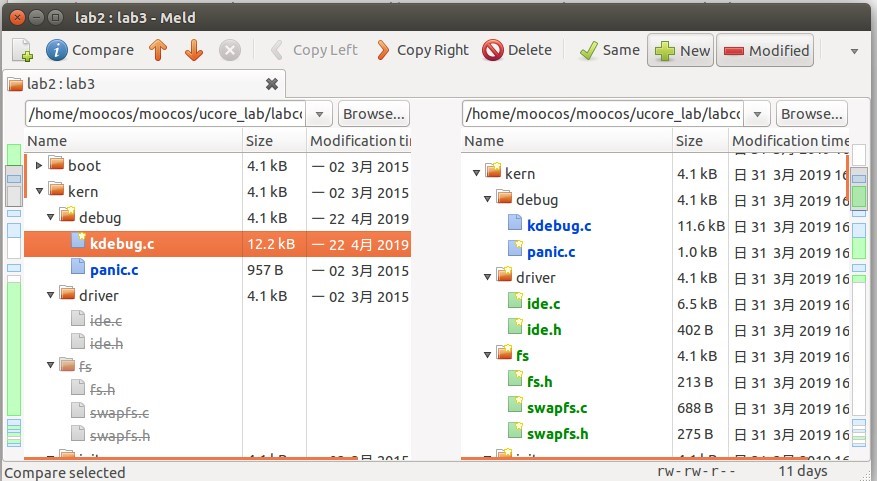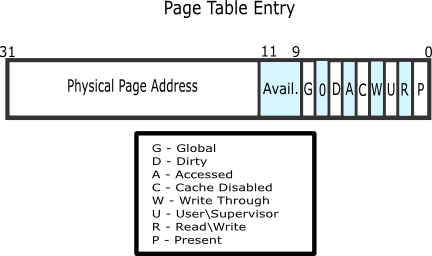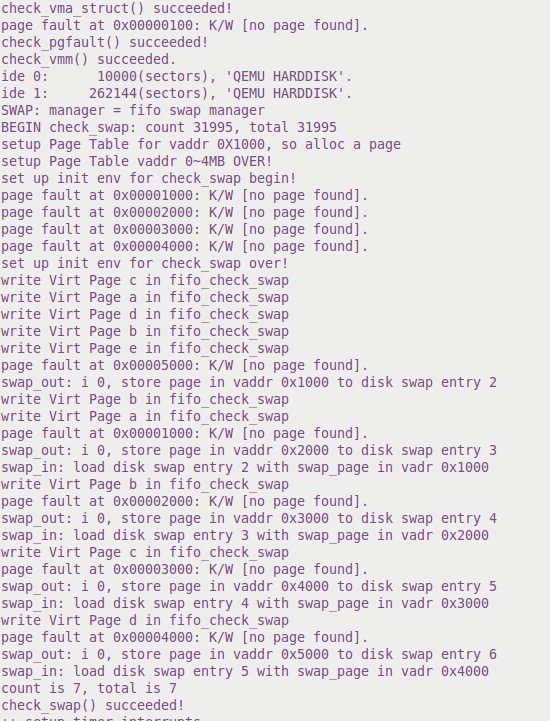lab3
【实验题目】
实验 4 虚拟内存管理
【实验目的】
- 了解虚拟内存的 Page Fault 异常处理实现
- 了解页替换算法在操作系统中的实现
【实验要求】
练习 0 :填写已有实验
练习 1 :给未被映射的地址映射上物理页(需要编程
练习 2 :补充完成基于 FIFO 的页面替换算法(需要编程)
【实验方案】
练习 0
这里使用的是系统自带的meld 工具进行整合,只需要选择两个文件夹,然后进行比较,在需要修改的文件中点击 Compare, 填充代码。

练习 1
do_pgfault 函数是这次要填写的内容
/* do_pgfault - interrupt handler to process the page fault execption
* @mm : the control struct for a set of vma using the same PDT
* @error_code : the error code recorded in trapframe->tf_err which is setted by x86 hardware
* @addr : the addr which causes a memory access exception, (the contents of the CR2 register)
*
* CALL GRAPH: trap--> trap_dispatch-->pgfault_handler-->do_pgfault
* The processor provides ucore's do_pgfault function with two items of information to aid in diagnosing
* the exception and recovering from it.
* (1) The contents of the CR2 register. The processor loads the CR2 register with the
* 32-bit linear address that generated the exception. The do_pgfault fun can
* use this address to locate the corresponding page directory and page-table
* entries.
* (2) An error code on the kernel stack. The error code for a page fault has a format different from
* that for other exceptions. The error code tells the exception handler three things:
* -- The P flag (bit 0) indicates whether the exception was due to a not-present page (0)
* or to either an access rights violation or the use of a reserved bit (1).
* -- The W/R flag (bit 1) indicates whether the memory access that caused the exception
* was a read (0) or write (1).
* -- The U/S flag (bit 2) indicates whether the processor was executing at user mode (1)
* or supervisor mode (0) at the time of the exception.
*/
用于处理 page fault 产生的异常,其中异常主要分为三种,页不存在、页在外存、没有权限等。
在函数中出现两个新出现的结构体 mm_struct:
// the control struct for a set of vma using the same PDT
struct mm_struct {
list_entry_t mmap_list; // linear list link which sorted by start addr of vma
struct vma_struct *mmap_cache; // current accessed vma, used for speed purpose
pde_t *pgdir; // the PDT of these vma
int map_count; // the count of these vma
void *sm_priv; // the private data for swap manager
};
很显然,它是同一个页表目录项下所有 vma 的控制单元,首先包含了一个链表节点指向 vma,一个充当 cache 的 vma_struct 指针,PDT 的指针,vma 数量以及swap manager。
vm_struct
// the virtual continuous memory area(vma), [vm_start, vm_end),
// addr belong to a vma means vma.vm_start<= addr <vma.vm_end
struct vma_struct {
struct mm_struct *vm_mm; // the set of vma using the same PDT
uintptr_t vm_start; // start addr of vma
uintptr_t vm_end; // end addr of vma, not include the vm_end itself
uint32_t vm_flags; // flags of vma
list_entry_t list_link; // linear list link which sorted by start addr of vma
};
表示一个连续的虚拟内存块,包含 PDT 指针,首地址,尾地址等。
练习 1 的注释:
/*LAB3 EXERCISE 1: YOUR CODE
* Maybe you want help comment, BELOW comments can help you finish the code
*
* Some Useful MACROs and DEFINEs, you can use them in below implementation.
* MACROs or Functions:
* get_pte : get an pte and return the kernel virtual address of this pte for la
* if the PT contians this pte didn't exist, alloc a page for PT (notice the 3th parameter '1')
* pgdir_alloc_page : call alloc_page & page_insert functions to allocate a page size memory & setup
* an addr map pa<--->la with linear address la and the PDT pgdir
* DEFINES:
* VM_WRITE : If vma->vm_flags & VM_WRITE == 1/0, then the vma is writable/non writable
* PTE_W 0x002 // page table/directory entry flags bit : Writeable
* PTE_U 0x004 // page table/directory entry flags bit : User can access
* VARIABLES:
* mm->pgdir : the PDT of these vma
*
*/
可以看到练习 1 的目的是要获得 PTE,如果不存在则新建一个 PT,因而可以使用 get_pte 函数来实现,如果获得的 PTE 为空,则为其分配一个页并修改页表完成虚地址对物理地址的映射,使用 pgdir_alloc_page 函数实现。除此之外还要注意处理函数调用的错误信息。
//(1) try to find a pte, if pte's PT(Page Table) isn't existed, then create a PT.
if ((ptep = get_pte(mm->pgdir, addr, 1)) == NULL){
goto failed;
}
//(2) if the phy addr isn't exist, then alloc a page & map the phy addr with logical addr
if (*ptep == 0) {
if(pgdir_alloc_page(mm->pgdir, addr, perm) == NULL)
goto failed;
}
问题 1:请描述页目录项(Page Directory Entry)和页表项(Page Table Entry)中组成部分对 ucore 实现页替换算法的潜在用处。
页表项与页目录项相似
 高 20 位用于存储物理页的地址,而低 12 位作为功能位在 mmu.h 我们可以找到 PTE 和 PDE 的功能信息
高 20 位用于存储物理页的地址,而低 12 位作为功能位在 mmu.h 我们可以找到 PTE 和 PDE 的功能信息
PTE_P 物理页是否存在
PTE_W 物理页是否可写
PTE_U 用户态是否可访问
PTE_PWT 物理页是否为写直达,可以向更低级的储存设备写入
PTE_PCD 物理页是否可以放入缓存
PTE_A 物理页是否可被访问
PTE_D 物理页是否可被写
PTE_PS 物理页大小
PTE_MBZ 必须为 0
PTE_AVAIL 由软件自定
这些功能位是判断是否出现页错误和是否被替换的重要依据
页目录项存储了所有页物理地址与虚拟地址的对应,而页表项则存储这些页的信息。
问题 2:如果 ucore 的缺页服务例程在执行过程中访问内存,出现了页访问异常,请问硬件要做哪些事情?
CPU 会把产生异常的线性地址存储在 CR2 中,并且把表示页访问异常类型的值(简称页访问异常错误码,errorCode)保存在中断栈中。然后调用 do_pgfault 进行处理。
**练习 2: **
练习 2 要实现的是基于 FIFO 的页面替换算法,首先要填补的还是 do_pgfault 函数
#if 0
/*LAB3 EXERCISE 1: YOUR CODE*/
ptep = ??? //(1) try to find a pte, if pte's PT(Page Table) isn't existed, then create a PT.
if (*ptep == 0) {
//(2) if the phy addr isn't exist, then alloc a page & map the phy addr with logical addr
}
else {
/*LAB3 EXERCISE 2: YOUR CODE
* Now we think this pte is a swap entry, we should load data from disk to a page with phy addr,
* and map the phy addr with logical addr, trigger swap manager to record the access situation of this page.
*
* Some Useful MACROs and DEFINEs, you can use them in below implementation.
* MACROs or Functions:
* swap_in(mm, addr, &page) : alloc a memory page, then according to the swap entry in PTE for addr,
* find the addr of disk page, read the content of disk page into this memroy page
* page_insert : build the map of phy addr of an Page with the linear addr la
* swap_map_swappable : set the page swappable
*/
if(swap_init_ok) {
struct Page *page=NULL;
//(1)According to the mm AND addr, try to load the content of right disk page
// into the memory which page managed.
//(2) According to the mm, addr AND page, setup the map of phy addr <---> logical addr
//(3) make the page swappable.
}
else {
cprintf("no swap_init_ok but ptep is %x, failed\n",*ptep);
goto failed;
}
}
#endif
代码的流程大致为:首先对 swap 进行初始化,成功后根据 mm 和 addr 将正确的磁盘中的页换到 page 中(swap_in 函数),换取成功后建立虚拟地址到物理地址的映射(page_insert 函数),最后完成页置换(swap_map_swappable)。 根据此流程编写代码如下
if(swap_init_ok){
struct Page *page = NULL;
if((ret = swap_in(mm,addr,&page))!=0) //(1)According to the mm AND addr, try to load the content of right disk page
goto failed; // into the memory which page managed.
page_insert(mm->pgdir,page,addr,perm); //(2) According to the mm, addr AND page, setup the map of phy addr <---> logical addr
swap_map_swappable(mm,addr,page,1);
page->pra_vaddr = addr; //(3) make the page swappable.
}else{
cprintf("no swap_init_ok but ptep is %x, failed\n", *ptep);
goto failed;
}
接下来需要完成 map_swappable 和 swap_out_victim 函数
map_swappable 是将最近使用的页加入到 pra_list_head 队列中,需要我们完成的代码只有添加部分
/*LAB3 EXERCISE 2: YOUR CODE*/
//(1)link the most recent arrival page at the back of the pra_list_head qeueue.
list_add(head, entry);
swap_out_victim 则是选择将要被置换的页,因为使用的 FIFO,因此会找到最先进入队列的页,进行置换。
/*LAB3 EXERCISE 2: YOUR CODE*/
//(1) unlink the earliest arrival page in front of pra_list_head qeueue
//(2) set the addr of addr of this page to ptr_page
list_entry_t *entry = head->prev;
struct Page *page = le2page(entry,pra_page_link);
list_del(entry);
*ptr_page = page;
return 0;
问题1
如果要在 ucore 上实现“extended clock 页替换算法”请给你的设计方案,现有的 swap_manager 框架是否足以支持在 ucore 中实现此算法?如果是,请给你的设计方案。
在练习 1 中我们看到页表中拥有 access,和 dirty 位,利用这两个功能位就可以检测页表是否被访问过或者被修改过,从而完成 extended clock 页替换算法
- 需要被换出的页的特征是什么?
最早被加入且未被访问过的页表。 - 在 ucore 中如何判断具有这样特征的页?
将页表与 PTE_A 相与,若为 0,则未被访问过 - 何时进行换入和换出操作?
所需的页不在页表中且页表已满【实验过程】
完成代码编写后,在命令行使用 make qemu, 结果如下

出现了一次探测页错误的过程与 5 次页置换过程。
check_pgfault() succeeded!与 check_swap() succeeded!成功输出,结果正确
 make grade 成功通过
make grade 成功通过